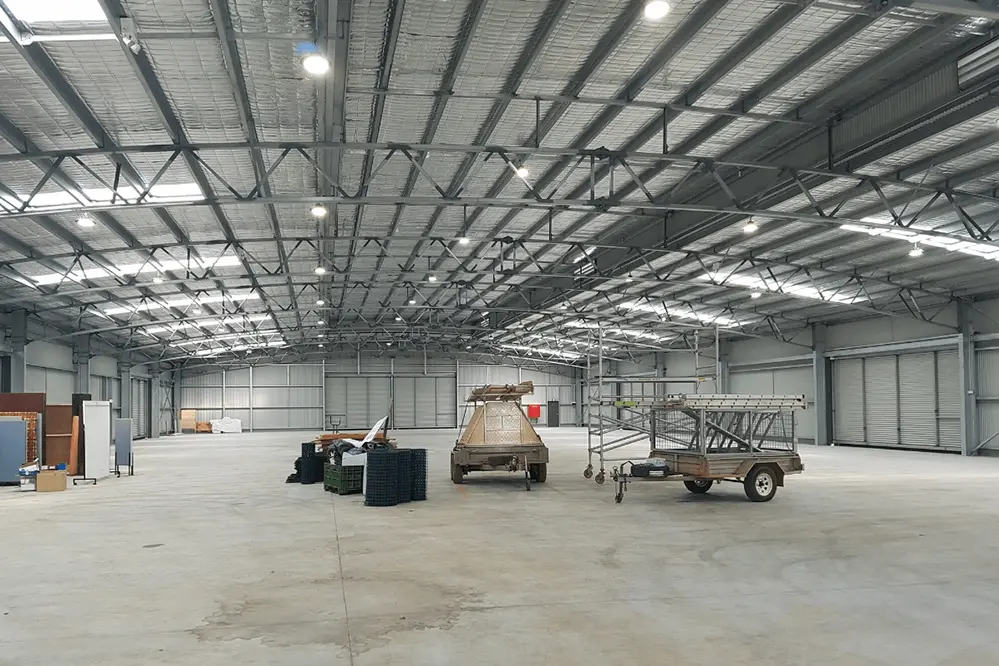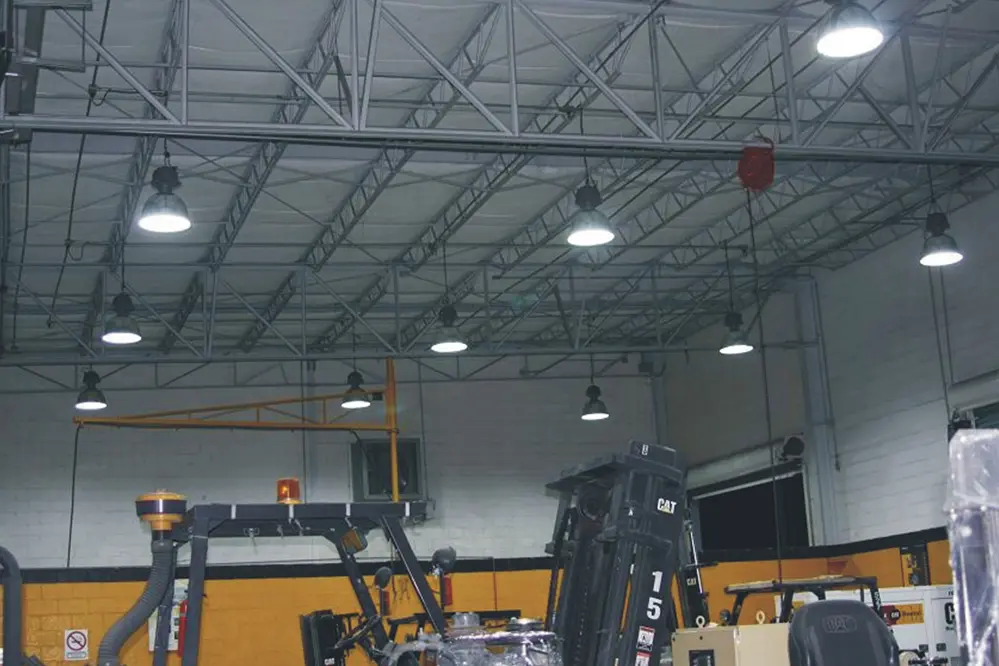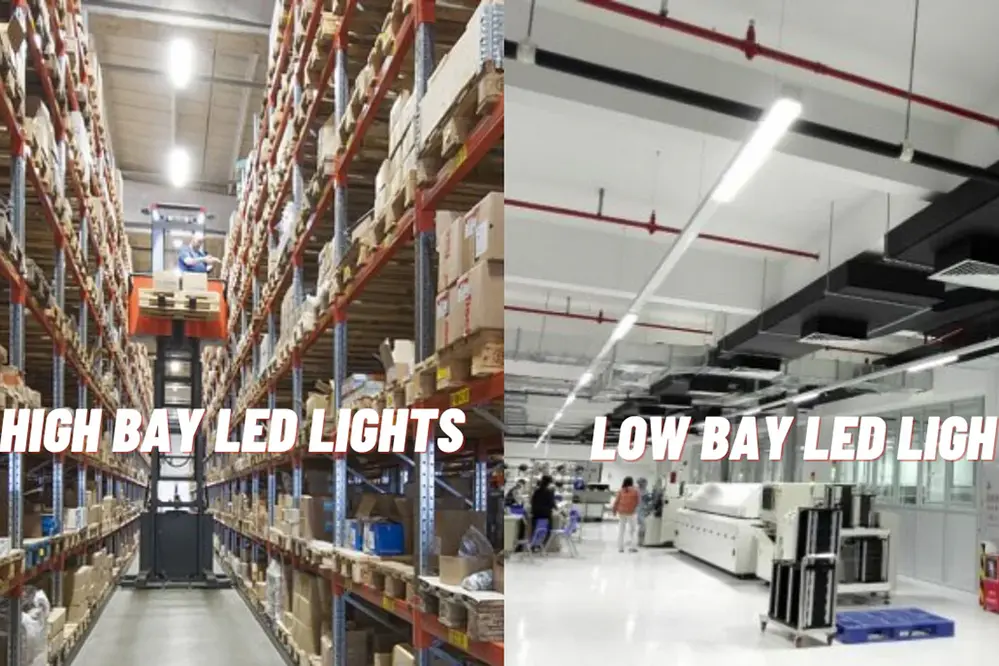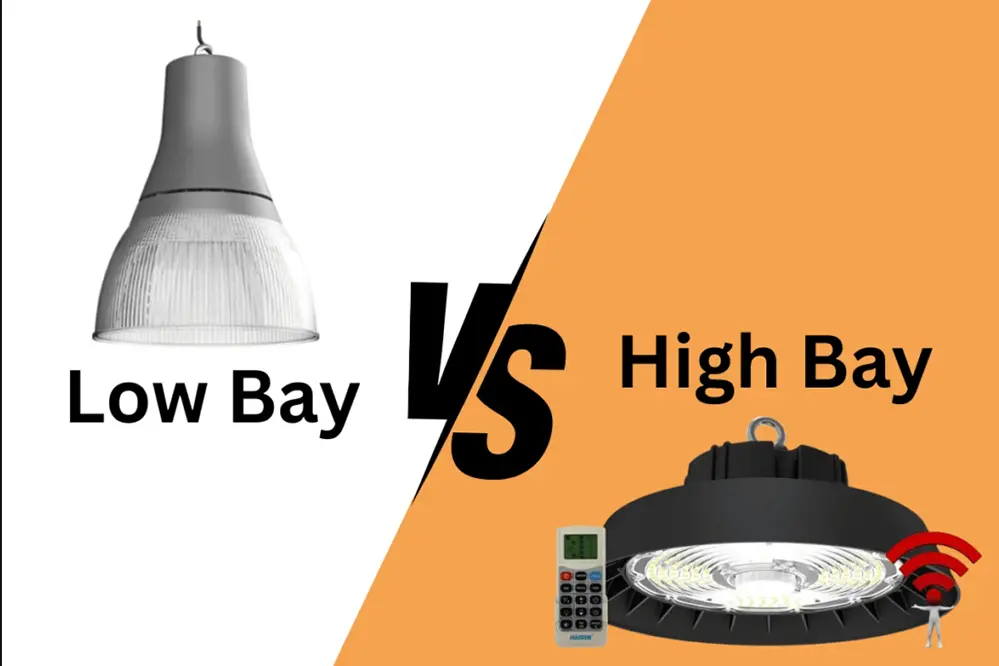In the dynamic world of industrial and commercial lighting, the choice between high bay vs low bay lighting can be a game-changer. Imagine a bustling warehouse where every corner is brilliantly illuminated, enhancing both safety and productivity. This transformation is often the result of selecting the right lighting solution, tailored to the specific needs of the space. High bay lighting, designed for ceilings over 20 feet, offers powerful illumination for expansive areas, while low bay lighting is perfect for ceilings under 20 feet, providing focused light where it’s needed most.
The importance of understanding these lighting options cannot be overstated. With lighting accounting for nearly 20% of global electricity consumption, making informed decisions can lead to significant energy savings and environmental benefits. Moreover, the right lighting enhances visibility, improves safety, and boosts employee productivity. By distinguishing between high bay and low bay lighting, businesses can optimize their environments, creating spaces that are both efficient and inviting.
As we delve deeper into the nuances of high bay vs low bay lighting, you’ll discover the key differences that can guide your decision-making process. Whether you’re aiming to enhance the ambiance of a retail space or improve the functionality of a manufacturing facility, understanding these lighting solutions is your first step toward a brighter, more efficient future. Join us as we explore the intricacies of these lighting options and illuminate the path to your success.
Understanding High Bay and Low Bay Lighting
How does one decipher the practical nuances and select the appropriate lighting for their expansive interior space?
High bay lighting, designed for ceilings 20 feet or higher, is engineered to illuminate vast areas such as warehouses or gymnasiums. Its high wattage and powerful luminescence penetrate deep spaces, allowing for an efficient spread of light that minimizes shadows.
In contrast, low bay lighting is tailored for ceilings reaching up to 20 feet, making it the ideal choice for retail stores and smaller industrial spaces. The lower mounting height achieves more focused illumination, ensuring every corner is well-lit.
Recognizing your facility’s height and specific lighting needs will guide you in selecting between these two types. These distinctions not only optimize visibility but also enhance energy efficiency, ultimately leading to cost savings.
By mastering either system, you harness the potential to transform any space into a vibrant and optimally-lit environment.
Applications of High Bay Lighting

High bay lighting finds its quintessential application in environments such as warehouses, factories, sports arenas, and large conference rooms where high ceilings are the norm. These spaces benefit from the comprehensive, bright illumination that high bay lights provide, ensuring maximum visibility and safety for workers and participants.
Adopting high bay lighting solutions equips businesses with the flexibility and clarity essential for efficient operations, enhancing both the functionality and the aesthetics of expansive interior environments.
Industrial Facilities
In industrial facilities, efficient lighting is paramount—affecting productivity, safety, and the overall functionality of large working areas.
Proper illumination in factories can reduce accidents, thus significantly increasing operational efficiency and ensuring worker safety.
High bay and low bay fixtures play a crucial role in these settings, where ceiling heights and the nature of tasks are varied. High bay lighting is typically employed in spaces with tall ceilings, offering expansive coverage ideal for areas needing uniform, intense illumination.
Conversely, low bay lighting is suited for lower ceilings, providing targeted, ambient lighting that enhances visibility where precision is necessary. Choosing the correct lighting can drive productivity, safety, and energy efficiency in industrial operations.
Sports Arenas
Sports arenas consistently seek lighting solutions that enhance both athletes’ performance and spectators’ experiences. How does the choice between high bay and low bay lighting play into this dynamic?
In vast arenas, high bay lighting systems are indispensable. Offering powerful illumination, these lights ensure every corner of the field or court is evenly lit, minimizing shadows and enabling athletes to perform under optimal conditions.
Moreover, high bay lights deliver consistent, bright lighting that accentuates details, crucial for high-definition broadcasts. This level of clarity is pivotal for both live audiences and countless viewers tuning in from around the world.
While low bay lighting might be used in auxiliary spaces like corridors or clubhouses, the game environment craves the brilliance that only high bay lights can provide. This choice underscores the importance of tailoring lighting solutions to specific arena demands and functions.
Selecting the appropriate lighting type elevates the experience and performance, advancing sports to unprecedented levels.
Applications of Low Bay Lighting

Low bay lighting finds its place in environments where lower ceilings prevail, such as retail stores, classrooms, and small warehouses. These settings demand a lighting approach that enhances both the ambiance and functionality, ensuring interactions are visually pleasant and productivity is maximized in spaces that thrive on balanced illumination.
Such lighting systems offer brilliant energy efficiency and are designed to meet the specific visibility and comfort needs of spaces where activities occur closer to ground level.
Retail Spaces
In the dynamic world of retail spaces, the differentiation between high bay vs low bay lighting becomes profoundly significant, each offering a unique advantage tailored to distinct settings.
Low bay lighting is the ideal choice for retail environments adorned with lower ceilings.
Contrastingly, high bay lighting serves its purpose in spaces with lofty ceilings, where expansive illumination is key.
These lighting options enhance the shopping experience by ensuring merchandise is effortlessly visible and atmospherics are inviting.
Choosing the correct lighting solution in retail is crucial, helping to accentuate product displays, create a welcoming environment, and ultimately drive sales by captivating customers with vibrant, well-lit surroundings.
Remember, the art of retail is not just about what’s being sold, but how it’s showcased. Proper illumination plays a pivotal role in achieving a customer’s heart and a store’s success.
Residential Settings
In residential settings, the application of high bay vs low bay lighting opens up fascinating possibilities for enhancing home ambiance.
While high bay lighting typically shines in industrial or commercial spaces with elevated ceilings, low bay lighting, with its softer illumination, offers the charming advantage of adding warmth to traditional residential environments. Its subtle brilliance gracefully complements lower ceilings, spaces frequently characterized by intimate settings requiring gentle lighting. Embracing these lighting distinctions enables homeowners to craft personalized living spaces that prioritize comfort without compromising on aesthetics.
Innovatively, this lighting selection can amplify the architectural features of any residence. While oversized fixtures might overwhelm a dwelling, strategically positioned low bay lights can create delightful accents, emphasizing unique elements within the home and allowing homeowners latitude to explore various decorative styles.
Ultimately, discerning the differences in high bay vs low bay lighting empowers homeowners to transform their living quarters into sanctuaries of illumination tailored to their personal tastes. Low bay lighting, in particular, holds the power to foster environments that are not only functionally illuminated but also emotionally fulfilling, demonstrating that adept lighting choices are the cornerstone of residential tranquility.
Key Features of High Bay Lighting
High bay lighting is specifically designed to illuminate expansive spaces with high ceilings, often found in industrial and commercial settings.
In recent years, advancements in high bay lighting technology, particularly in LED fixtures, have revolutionized how vast spaces such as warehouses, factories, and gymnasiums are lit, improving both efficiency and visibility. The ability to cast powerful, uniform illumination over large areas with fewer fixtures has made high bay lighting an industry staple, ensuring operations continue seamlessly, even during night shifts.
The placement of high bay lights is critical to achieve optimal lighting performance. Typically installed at a height of 20 feet or more, these lights utilize reflectors or lenses to distribute light evenly, minimizing shadows and glare. Moreover, the integration of smart lighting controls and sensors enhances the adaptability of high bay lighting systems, allowing businesses to tailor lighting according to their unique needs.
The robust nature of these fixtures is also noteworthy, with designs that support durability and longevity, even in challenging environments. Whether it’s the resilience to withstand temperature fluctuations or the ability to operate efficiently in dust-prone areas, high bay lighting proves itself formidable under pressure, consistently delivering unparalleled performance.
Overall, high bay lighting stands out as a powerful lighting solution for any large-scale application needing efficient illumination.
Key Features of Low Bay Lighting
Low bay lighting is incredibly versatile and effective.
Designed for ceilings less than 20 feet high, these fixtures excel in spaces that demand precision lighting, such as retail environments or workshops where visibility is paramount. Typically, low bay lights are adept at delivering uniform brightness across relatively smaller areas. Consequently, they minimize glare and improve focus, crucial in settings where intricate tasks are performed.
The size and installation method of low bay lights are notably straightforward.
Their design facilitates easy maintenance and quick installation, making them an attractive choice for businesses looking to optimize light without significant overhaul. Furthermore, these lights often feature advanced options like dimmable settings and color temperature adjustments, providing flexibility and efficiency that businesses can easily adapt to their evolving demands.
In alignment with modern energy standards, low bay lighting has evolved to embrace sustainability without compromising performance. Leveraging cutting-edge LED technology, these lights significantly reduce energy consumption and maintenance costs while offering superior light quality. As innovation continues to shape the industry, it’s clear that low bay lighting stands poised to illuminate the path toward sustainable, efficient, and cost-effective commercial lighting solutions.
Advantages of High Bay Lighting
Elevates spaces with powerful illumination and efficiency.
High bay lighting is designed to deliver both intensity and clarity. This robust lighting solution casts bright and even illumination across expansive vertical areas, making it an integral enhancement for settings that require sharp visibility. Consequently, adoption of this technology can significantly heighten the operational efficacy of environments with high ceilings.
These lights ensure unparalleled visibility in extensive facilities.
With impressive light distribution, high bay fixtures mitigate shadows – an essential aspect for facilities with complex operational demands where visibility is crucial – and consequently facilitate safe yet highly-productive workspaces.
With energy-efficient models and advanced controls, such as smart sensors and adjustable luminosity, high bay fixtures are at the forefront of green lighting initiatives for a new year and beyond. These systems not only bolster ecological efforts but also present industry leaders with proactive strategies for improving workplace efficiency and reducing operational expenses over time.
Advantages of Low Bay Lighting
Low bay lighting solutions are perfectly tailored for facilities where ceilings do not exceed 20 feet, and they offer exceptional benefits for such environments.
Their design facilitates excellent light distribution, ensuring ample coverage for zones with lower ceilings.
Low bay fixtures provide a balance of optimal brightness and energy efficiency that makes them a beacon of practicality in various settings, including retail spaces, workshops, and other commercial environments where clarity and precision are paramount.
The inherent flexibility of these fixtures allows for easy integration into existing layouts, making them an ideal choice for businesses eager to optimize operational environments without the need for extensive infrastructure modifications. By incorporating options like dimming capabilities and adaptive designs, they truly represent a “smart” investment for enhancing productivity and visual comfort.
Choosing Between High Bay and Low Bay Lighting

Selecting the appropriate lighting is crucial.
When choosing between high bay and low bay lighting, every element counts. The decision hinges on several key factors intrinsic to your facility’s structure, such as ceiling height, required light intensity, and energy consumption needs. Strategically, deciding on one of these systems can significantly influence the operational efficiency and visual clarity within your space.
Height largely dictates the choice between these systems.
Consider the expanse of your area – high bay lighting is quintessential for vast spaces with towering ceilings of 20 feet or more. In contrast, low bay lighting is optimally designed for regions with lower ceilings, ensuring just the right amount of luminance.
In the new year and beyond, lighting technology advances continue to redefine the boundaries of interior illumination, offering solutions that align seamlessly with sustainability and precision demands. Assessing your facility’s specific needs and understanding the nuances between high bay and low bay lighting will position you to make a forward-thinking choice that enhances both functionality and form.
Installation Considerations
When it comes to installation, precision is key.
Thorough planning can make all the difference. The placement and alignment of fixtures should be taken into careful consideration to maximize the lighting benefits, whether you’re dealing with expansive high bay applications or more intimate low bay settings. Additionally, understanding the scope of electrical work required for each fixture type optimizes the installation process.
Proper safety measures must always be adhered to.
It’s critical to account for the height of installations—while high bay systems might necessitate specialized equipment due to the elevated positioning, low bay installations are considerably more straightforward but still demand meticulous attention.
In the fast-evolving realm of lighting technology, selecting correct installation practices ensures not only operational safety but also long-term functionality. This approach guarantees that, regardless of technological advancements throughout the new year and beyond, your space will remain at the forefront of efficiency and illumination excellence.
Energy Efficiency Comparison
In the quest for sustainability, energy efficiency is paramount when choosing lighting solutions.
High bay lighting, due to its strategic placement at greater heights, often incorporates advanced technology, which maximizes energy conservation and enhances lumen output. These fixtures frequently utilize LED technology, known for its exceptional efficiency, significantly mitigating energy consumption while maintaining superior lighting quality. This makes high bay lights an attractive choice for businesses aiming to reduce their carbon footprint while achieving long-term cost savings.
Conversely, low bay lighting typically operates at reduced energy levels. Given its installation at lower heights, this type of lighting does not demand the same intensity or energy output as high bay lighting, rendering it more suitable for smaller or more enclosed spaces. This reduced energy requirement contributes to overall operational savings and environmental responsibility.
Ultimately, both high and low bay lighting options represent cutting-edge innovation, offering remarkable solutions tailored to specific needs. Whether illuminating vast warehouses or cozy retail spaces, they stand as a testament to today’s progressive lighting technology, delivering not only on energy efficiency but also on the promise of a brighter, more sustainable future. Harnessing the potential of energy-efficient lighting transforms environments, unlocking significant advancements in both sustainability and operational effectiveness.
Cost Factors to Consider
When contemplating high bay vs low bay lighting solutions, it’s crucial to scrutinize the cost implications of each option.
Initial installation costs vary between the two, with high bay lighting potentially incurring higher expenses due to the need for more powerful luminaires and elevated mounting heights. In contrast, low bay lighting systems can often be integrated with relative ease and minimal expense, especially in smaller or less demanding spaces.
Despite the possible higher upfront cost, high bay lighting often proves more cost-effective over the long haul due to its efficient illumination of expansive areas. The robust design and superior lumens output mean fewer fixtures are needed, which may reduce overall maintenance and replacement expenses. This efficiency translates to lower overall costs and increased savings over time.
Further tipping the scales in favor of high bay lighting is the advancement in LED technology. LED high bay lights offer unparalleled energy savings and enhanced durability, resulting in extended lifespans that reduce replacement frequency and cost, thereby maximizing value.
The decision hinges on evaluating long-term benefits against initial costs, ensuring your choice aligns with financial and operational goals.
Maintenance and Longevity
When considering high bay vs low bay lighting, maintenance and longevity are crucial factors influencing your decision.
High bay lighting fixtures are designed for robustness, making them ideal for expansive spaces where maintenance access is challenging. These lights feature solid construction to endure the rigors of high-altitude installation, thus requiring less frequent maintenance.
In contrast, low bay lighting, typically installed in more accessible locations, allows for easier maintenance. However, despite easier access, they might require more frequent upkeep due to potential exposure to more wear and dust accumulation.
LED technology in high bay fixtures delivers longer longevity with minimal maintenance. This extended lifespan translates into substantial savings and reduced operational disruptions, offering an exceptional return on investment.
Investing in durable and efficient lighting solutions enhances operational efficiency and reduces long-term costs. Choose wisely for drastic improvements.
Conclusion
In the realm of lighting solutions, clarity emerges when we understand the nuanced differences between high bay and low bay lighting. High bay lighting stands resilient in vast spaces, offering enduring quality and efficiency. Its towering presence is ideal for expansive areas, ensuring that every corner is brilliantly illuminated.
Conversely, low bay lighting delivers practicality in smaller vicinities, optimizing accessibility and ease of maintenance. This type of lighting is perfect for spaces with lower ceilings, providing focused illumination where it’s needed most. Each lighting type holds its quintessential place in the architectural symphony, contributing to the overall functionality and aesthetic of the environment.
Ultimately, aligning your lighting choice with spatial requirements and functional objectives ensures a harmonious blend of efficiency and aesthetics. Whether illuminating expansive warehouses or cozy aisles, your astute selection becomes the linchpin to dazzling success and operational excellence. The right lighting not only shines but also inspires, elevates, and transforms spaces into environments of success and excellence.





